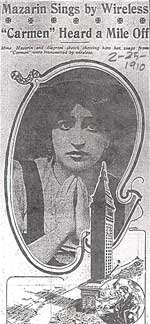
Birth of public radio broadcasting
Encyclopedia

Lee De Forest
Lee De Forest was an American inventor with over 180 patents to his credit. De Forest invented the Audion, a vacuum tube that takes relatively weak electrical signals and amplifies them. De Forest is one of the fathers of the "electronic age", as the Audion helped to usher in the widespread use...
. A 1907 Lee De Forest company advertisement said,
Date
On January 13, 1910, the first public radio broadcast was an experimental transmission of a live Metropolitan Opera HouseMetropolitan Opera House (39th St)
The Metropolitan Opera House was an opera house located at 1411 Broadway in New York City. Opened in 1883 and demolished in 1967, it was the first home of the Metropolitan Opera Company.-History:...
performance of several famous opera singers.
Performers
The first public radio broadcast consisted of performances of Cavalleria RusticanaCavalleria rusticana
Cavalleria rusticana is an opera in one act by Pietro Mascagni to an Italian libretto by Giovanni Targioni-Tozzetti and Guido Menasci, adapted from a play written by Giovanni Verga based on his short story. Considered one of the classic verismo operas, it premiered on May 17, 1890 at the Teatro...
and Pagliacci
Pagliacci
Pagliacci , sometimes incorrectly rendered with a definite article as I Pagliacci, is an opera consisting of a prologue and two acts written and composed by Ruggero Leoncavallo. It recounts the tragedy of a jealous husband in a commedia dell'arte troupe...
. Riccardo Martin
Riccardo Martin
Riccardo Martin was an American tenor.Born Hugh Whitfield Martin in Hopkinsville, Kentucky, Martin was granted an endowment which allowed him, in 1901, to go to Paris to study with Giovanni Sbriglia and Jean de Reszke; he later completed his studies with Vincenzo Lombardi in Florence and Beniamino...
performed as Turridu, Emmy Destinn
Emmy Destinn
Emmy Destinn was a Czech operatic soprano with a strong and soaring lyric-dramatic voice. She had a career both in Europe and at the New York Metropolitan Opera.- Biography :...
as Santuzza, and Enrico Caruso as Canio. The conductor was Egisto Tango
Egisto Tango
Egisto Tango was the conductor of several premieres by Bartók, including The Wooden Prince and Bluebeard's Castle....
. This wireless radio transmission event of the Italian tenor Enrico Caruso of a concert from the Metropolitan Opera House in New York City is regarded as the birth of public radio broadcasting.
The New York Times reported on January 14, 1910,
Receivers
The few radio receivers able to pick up this first-ever "outside broadcast" are those at the De Forest Radio Laboratory, on board ships in New York Harbor, in large hotels on Times Square and at New York city locations where members of the press were stationed at receiving sets. Public receivers with earphones had been set up in several well-advertised locations throughout New York City. There were members of the press stationed at various receiving sets throughout the city and the general public was invited to listen to the broadcast.The experiment was considered mostly unsuccessful. The microphones of the day were of poor quality and couldn't pick up most of the singing done on stage. Only off-stage singers singing directly into a microphone could be heard clearly. The New York Times reported the next day that static
Radio atmospheric
A radio atmospheric signal or sferic is a broadband electromagnetic impulse that occurs as a result of natural atmospheric lightning discharges. Sferics may propagate from their lightning source without major attenuation in the Earth-Ionosphere waveguide, and can be received thousands of...
and interference kept the homeless song waves from finding themselves.
Lee De Forest's Radio Telephone Company manufactured and sold the first commercial radios in the demonstration room at the Metropolitan Life Building in New York City for this public event.
Transmitter
The wireless transmitter had 500 watts of power. It is reported that this broadcast was heard 20 km away on a ship at sea. The broadcast was also heard in Bridgeport, ConnecticutBridgeport, Connecticut
Bridgeport is the most populous city in the U.S. state of Connecticut. Located in Fairfield County, the city had an estimated population of 144,229 at the 2010 United States Census and is the core of the Greater Bridgeport area...
.
Early music transmission
- The very first transmission of music by radio is credited to one Dr. Nussbaumer of the University of GrazUniversity of GrazThe University of Graz , a university located in Graz, Austria, is the second-largest and second-oldest university in Austria....
in 1904, however it was not to the general public. He yodeled an Austrian folk song into an experimental transmitter which was received in the next room at the university where he worked. He does not show in any standard reference works of science.
- Lee De Forest did a program of opera phonograph records from the Eiffel Tower in Paris in 1908. This was just an experimental stunt to other nearby hobbyists and not considered a public broadcast. The general public had no access to receivers at the time.
- When testing the radiotelephone for the Navy, Lee de Forest played patriotic phonograph music as the ships entered the harbor.

